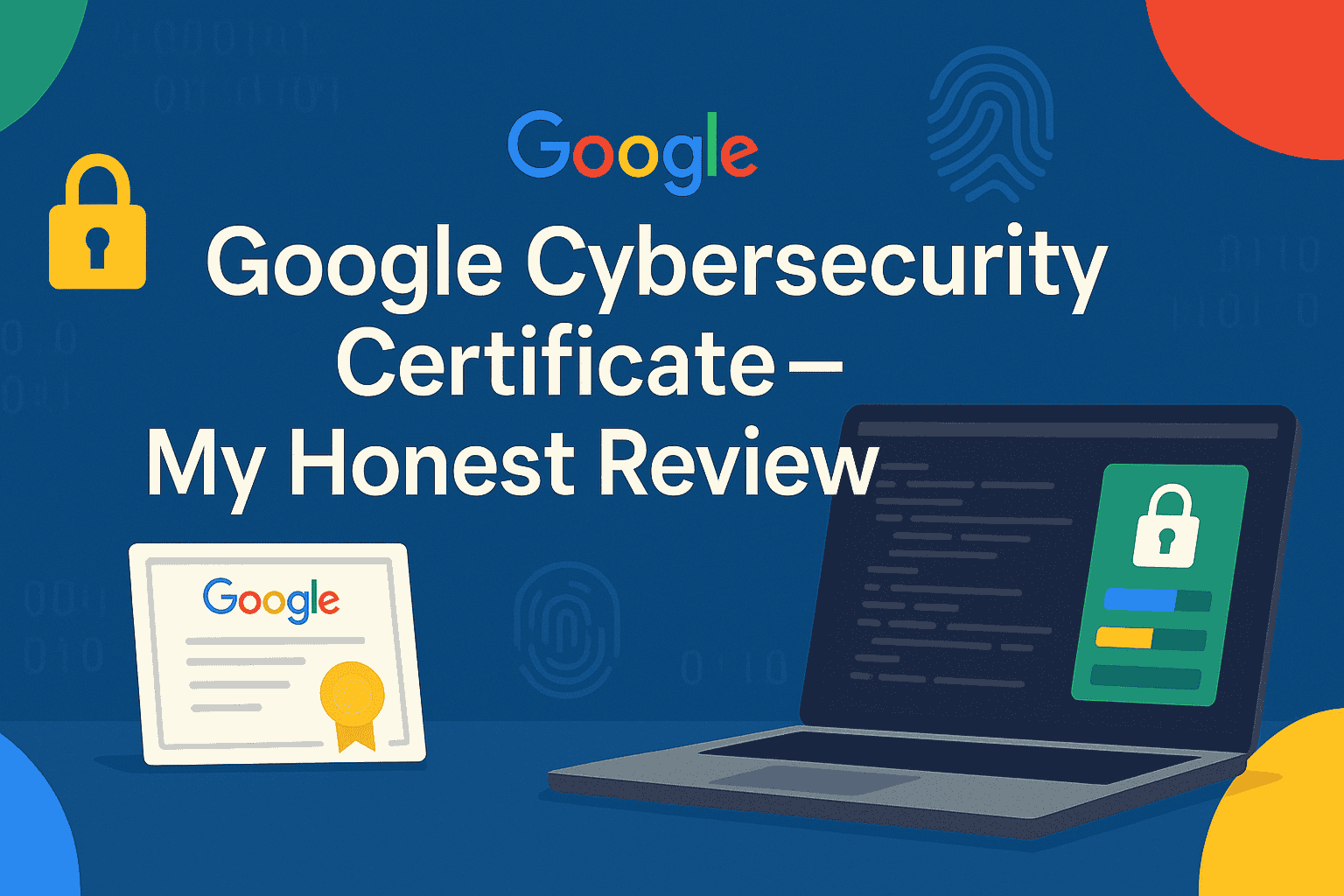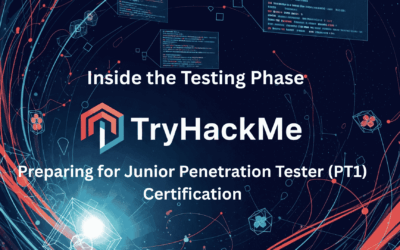Just completed the Google Cybersecurity Professional Certificate!
I recently wrapped up this beginner-friendly program from Coursera, backed by Google, and wanted to share my honest review and personal experience with anyone considering a path into cybersecurity.
In my latest blog post, I cover:
🔹 What the certificate includes
🔹 Key takeaways and skills learned
🔹 My hands-on experience with labs and tools
🔹 Pros & cons you should know before starting
If you’re thinking about transitioning into cybersecurity or just starting out, this post might help you decide if this course is the right fit.
Introduction
Back in 2016, I started an online course from a different vendor. At that time, even though I was studying for certifications like CompTIA Security+, the term “cybersecurity” wasn’t as popular as it is now. There were already many video tutorials on various platforms (youtube, udemy, others are now gone) related to cybersecurity, and I began to automate repetitive Network Engineer tasks that were performed monthly using Python programming. Learning cybersecurity at that stage was 100% theoretical and quite boring, similar to studying for the CCNA. However, I believe that theoretical foundation improved my cognitive and reasoning skills, which became valuable when I started working in the real world.
Now in 2025, Cybersecurity has always been a topic that fascinated me—partly due to its high-stakes nature, and partly because of its relevance in today’s digital world. As someone looking to deepen my understanding and refresh my knowledge. I decided to enroll in the Google Cybersecurity Professional Certificate offered through Coursera.
This blog post is a personal review based on my experience completing the entire certificate. I’ll walk you through what the program covers, how it’s structured, what I found valuable (and what I didn’t), and whether I think it’s worth your time and investment. If you’re a beginner, experience IT Professional or career switcher considering this certificate, I hope this post will give you some real-world insight before diving in.
About the Certificate
The Google Cybersecurity Professional Certificate is an entry-level program designed to prepare beginners for a career in cybersecurity. It’s offered by Google and hosted on Coursera, making it widely accessible to learners around the world. The program is part of Google’s broader effort to create pathways into tech for those without traditional experience or degrees.
The certificate is structured into eight self-paced courses, each focusing on different foundational aspects of cybersecurity. These include topics like risk management, incident response, security tools, scripting basics, and even a brief introduction to working in a Security Operations Center (SOC).
Here’s a quick overview of what you can expect:
- Level: Beginner-friendly; no prior experience required
- Duration: Designed to be completed in ~6 months at 10 hours per week (I completed it in just 13 days, depending on your experience)
- Cost: Covered under Coursera’s monthly subscription (around $14 USD/month in the Philippines but in other countries it’s a different price)
- Mode: 100% online, with video lectures, readings, quizzes, and hands-on labs (mostly using Qwiklabs)
The program also includes a capstone project, which ties together the skills learned across the courses and simulates real-world security tasks. It’s geared toward job readiness, with a focus on roles like security analyst, SOC analyst, and IT support with a security focus.
Going through the Google Cybersecurity Professional Certificate gave me a solid foundation in the core principles of cybersecurity. While the content was tailored for beginners, it still managed to cover a broad range of practical topics that are essential for anyone entering the field.
Here are some of the key concepts and skills I picked up during the program:
- Fundamentals of cybersecurity: I learned about the CIA triad (Confidentiality, Integrity, Availability), basic threat types, and common attack vectors like phishing, malware, and DDoS attacks.
- Risk management and security frameworks: The course introduced me to industry standards like NIST, and taught me how to identify, assess, and mitigate risks within an organization.
- Security tools and practices: I gained hands-on experience with tools such as Wireshark, Kali Linux, and SIEM platforms (through simulations). These tools were used to analyze traffic, investigate incidents, and respond to security events.
- Incident detection and response: I learned how SOC teams operate and how they use logs, alerts, and playbooks to detect and respond to incidents.
- Basic scripting with Python: One course was dedicated to automating simple security tasks using Python, which was especially helpful in understanding how coding can support security operations.
- Linux and system administration basics: I also picked up foundational Linux commands and file system navigation skills—critical for any technical cybersecurity role.
Beyond just technical content, the program also emphasized soft skills like ethical decision-making, communication in high-pressure environments, and career development tips.
While the program didn’t go too deep into advanced topics, it gave me a structured path to explore the field and helped me build confidence in understanding how cybersecurity works in real-world settings.
Pros and Cons
| ✅ Pros | ⚠️ Cons |
|---|---|
| Beginner-friendly and no prior experience required | Limited depth for intermediate/advanced learners |
| Clear structure with 8 well-organized courses | Some content can feel repetitive across modules |
| Hands-on labs using Qwiklabs simulate real-world tasks | Labs are guided—less room for open-ended exploration |
| Introduces industry tools like Wireshark, Linux, and SIEMs | No access to real enterprise environments or full tool installations |
| Good balance of theory and practical application | Some quizzes are overly simplistic and don’t test deeper understanding |
| Taught by Google professionals with real-world experience | Not a replacement for vendor-specific certifications (e.g., CompTIA) |
| Flexible, self-paced learning on Coursera | Monthly subscription cost adds up if not completed efficiently |
| Great introduction to SOC roles and career paths | No formal exam or proctored assessment at the end |
My Personal Experience
Taking the Google Cybersecurity Professional Certificate was a valuable and rewarding experience for me. I approached the program with a foundational knowledge of IT, but little formal cybersecurity training, so I was curious to see how well this course would bridge that gap—and for the most part, it did a great job.
What stood out the most was how approachable and structured the learning path was. Each course built logically on the previous one, and the instructors did a good job of simplifying complex topics without watering them down. The use of real-world scenarios, especially in incident response and risk management modules, helped me better understand how cybersecurity works in an organizational context.
I especially appreciated the Qwiklabs exercises, which allowed me to gain practical experience in a controlled environment. Being able to work with Linux terminals, analyze packet captures in Wireshark, and experiment with SIEM interfaces gave me more confidence in my hands-on abilities. That said, I did feel that some labs were too guided, and I wished there were more opportunities to troubleshoot or explore independently.
One of the highlights for me was the final capstone project, which required applying many of the skills learned throughout the program. It felt like a mini simulation of a real SOC environment, and it helped tie everything together in a meaningful way.
However, I also noticed that certain sections felt repetitive—particularly the explanations of security principles, which were echoed across multiple courses. While this might be helpful for absolute beginners, it slowed me down at times.
The Python automation section is only just focused on the programming but they never touch how run the code in Linux command, introducing a different code editor and Python Environment. You need to make an effort and learn course from other platform, in Youtube I would recommend the channel Programming with Mosh, you would learn something Python in just two hours and do some real world project.
In the packet analysis subject I would recommend go deeper on this one by solving and acquiring this badge PCAP in pentesterlab.com
Overall, the experience was both motivating and affirming. I came away with a clearer sense of what cybersecurity roles involve, and it reinforced my desire to pursue more advanced studies and certifications in the field.
Final Thoughts
Completing the Google Cybersecurity Professional Certificate was a solid step forward in my journey toward understanding the cybersecurity landscape. While it’s not a deep-dive into advanced topics, it serves as an excellent starting point—especially for beginners, career changers, or anyone looking to get a structured overview of the field.
The content was thoughtfully designed, the labs were practical, and the real-world focus gave me a clearer idea of what cybersecurity roles actually entail. That said, it’s important to see this program as a foundation, not a destination. To become job-ready, especially for technical roles, you’ll still need to gain more hands-on experience, possibly pursue additional certifications, and continue learning through personal projects or internships.
Would I recommend it? Yes—if you’re just starting out and want an accessible, well-paced introduction to cybersecurity, this is a great way to begin. It’s affordable, flexible, and backed by a name like Google, which certainly adds credibility.
For me personally, this course has sparked even more interest in the field, and I’m excited to keep building on what I’ve learned. If you’re considering this certificate, go into it with the mindset that it’s a launchpad—not the finish line.



